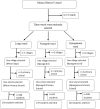Persistence of Schistosoma haematobium transmission among school children and its implication for the control of urogenital schistosomiasis in Lindi, Tanzania
- PMID: 35167622
- PMCID: PMC8846507
- DOI: 10.1371/journal.pone.0263929
Persistence of Schistosoma haematobium transmission among school children and its implication for the control of urogenital schistosomiasis in Lindi, Tanzania
Abstract
Background: Despite twelve rounds of school-based preventive chemotherapy for schistosomiasis in endemic areas of Tanzania such as Mtama district, Lindi: the burden of Schistosoma haematobium infection has remained highly conceivable due to re-infections. The factors associated with continuity of S.haematobium transmission in Mtama district, Lindi have not been fully established. This study investigated the burden and factors contributing to the ongoing transmission of S.haematobium infection in the endemic district of Mtama, Lindi.
Methods: A quantitative cross-sectional survey was carried out among 649 school-age children in the Mtama district to determine the burden and factors associated with continuity of S.haematobium infection transmission. A single urine specimen was obtained from each pupil and tested for macro- and microhaematuria, presence of S.haematobium ova, as well intensity of infection; this was complemented with a survey of Bulinus spp snail intermediate hosts and their infectivity. A structured questionnaire was employed to gather information on individual and environmental risk factors for S.haematobium transmission. Summary statistics were computed for individual variables; while a univariate and multivariate logistic regression analysis was performed to assess the association between risk factors with S.haematobium infection.
Results: Prevalence of S.haematobium infection by macro- and microhaematuria was 13.1% and 46.2% respectively. The prevalence of S.haematobium ova was 52.7%; intensity of infection was light in 53.1%, and heavy in 46.9%. Snail intermediate hosts were Bulinus globosus and B.nasutus, whose infectivity was 2.2% and 1.3%, respectively. Among the assessed risk factors, long residency (10-13 years) in the area was a significant risk factor for the continuity of S.haematobium transmission (AOR: 21.79, 95% CI: 1.37-346.4).
Conclusions: The observed 52.7% prevalence of S.haematobium infection represents unacceptably high prevalence after 12 rounds of preventive chemotherapy. Therefore, an urgent need for the implementation of integrated multiple control interventions in the Mtama district; is considered to be imperative.
Conflict of interest statement
The authors have declared that no competing interests exist.
Figures





Similar articles
-
Prevalence and risk factors of urogenital schistosomiasis among under-fives in Mtama District in the Lindi region of Tanzania.PLoS Negl Trop Dis. 2022 Apr 20;16(4):e0010381. doi: 10.1371/journal.pntd.0010381. eCollection 2022 Apr. PLoS Negl Trop Dis. 2022. PMID: 35442997 Free PMC article.
-
Geographical and behavioral risks associated with Schistosoma haematobium infection in an area of complex transmission.Parasit Vectors. 2018 Aug 25;11(1):481. doi: 10.1186/s13071-018-3064-5. Parasit Vectors. 2018. PMID: 30144807 Free PMC article.
-
Urogenital schistosomiasis among adult male population in an endemic area of southern Tanzania: a descriptive cross-sectional study.BMJ Open. 2024 Jun 17;14(6):e079690. doi: 10.1136/bmjopen-2023-079690. BMJ Open. 2024. PMID: 38889945 Free PMC article.
-
Epidemiological dynamics and associated risk factors of S. haematobium in humans and its snail vectors in Nigeria: a meta-analysis (1983-2018).Pathog Glob Health. 2020 Mar;114(2):76-90. doi: 10.1080/20477724.2020.1728164. Epub 2020 Mar 17. Pathog Glob Health. 2020. PMID: 32182201 Free PMC article.
-
Interactions between intermediate snail hosts of the genus Bulinus and schistosomes of the Schistosoma haematobium group.Parasitology. 2001;123 Suppl:S245-60. doi: 10.1017/s0031182001008046. Parasitology. 2001. PMID: 11769287 Review.
Cited by
-
Freshwater snail-borne parasitic diseases in Africa.Trop Med Health. 2024 Sep 20;52(1):61. doi: 10.1186/s41182-024-00632-1. Trop Med Health. 2024. PMID: 39304958 Free PMC article. Review.
-
Sexual and reproductive health among men with genital schistosomiasis in southern Tanzania: A descriptive study.PLOS Glob Public Health. 2024 Mar 27;4(3):e0002533. doi: 10.1371/journal.pgph.0002533. eCollection 2024. PLOS Glob Public Health. 2024. PMID: 38536825 Free PMC article.
-
Urogenital schistosomiasis in schoolchildren in the lake zones of Kankossa and Oued Rawdha, southern Mauritania: The first parasitological and malacological survey.PLoS Negl Trop Dis. 2024 Sep 25;18(9):e0012505. doi: 10.1371/journal.pntd.0012505. eCollection 2024 Sep. PLoS Negl Trop Dis. 2024. PMID: 39321164 Free PMC article.
-
Prevalence and factors associated with ongoing transmission of Schistosoma haematobium after 12 rounds of Praziquantel Mass Drug Administration among school age children in Southern Tanzania.Parasite Epidemiol Control. 2023 Sep 1;23:e00323. doi: 10.1016/j.parepi.2023.e00323. eCollection 2023 Nov. Parasite Epidemiol Control. 2023. PMID: 37692460 Free PMC article.
-
Burden and factors associated with ongoing transmission of soil-transmitted helminths infections among the adult population: A community-based cross-sectional survey in Muleba district, Tanzania.PLoS One. 2023 Jul 26;18(7):e0288936. doi: 10.1371/journal.pone.0288936. eCollection 2023. PLoS One. 2023. PMID: 37494358 Free PMC article.
References
-
- World Health Organization. Key facts-schistosomiasis-2019. Geneva, Switzerland. Available from: https://www.who.int/news-room/fact-sheets/detail/schistosomiasis (Accessed August 5, 2021).
Publication types
MeSH terms
LinkOut - more resources
Full Text Sources
Research Materials
Miscellaneous

